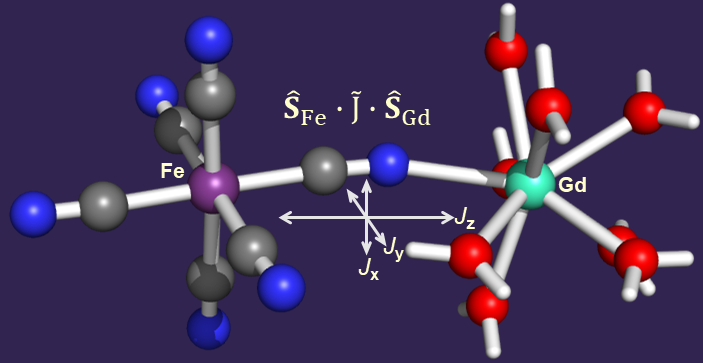3d - 4f Interactions
 The nature of the magnetic interactions between 3d and 4f ions is not well understood.
Due to their large spin S ≤ 7/2, large magnetic moment L ≤ 6, and large anisotropy that is intrinsic to most rare-earths, lanthanide-containing
synthons are ideally suited for the construction of single-molecule and single-ion magnets. The radial distribution of the 4f electrons
of lanthanide ions is contracted such that they are effectively shielded by the outer, doubly-occupied, 5s and 5p orbitals. Consequently,
magnetic interactions between 3d and 4f ions are very weak. However, these interactions are not negligible and they have a profound effect on
the magnetic properties of 3d-4f complexes. Current state-of-the-art theoretical modeling has had limited success in the description and
prediction of these subtle exchange interactions. Since the first report in 1985 of a [CuGd] dimer, theoretical rationalizations of 3d-4f exchange
interactions have advanced rather little beyond initial
qualitative descriptions. Two basic mechanisms through which these interactions might occur have been proposed. Gatteschi et al. invoked the spin
polarization of the 6s orbital, which in turn overlaps slightly with the 3d orbitals of the transition metal site. Kahn et al. suggested that ferromagnetic
couplings are enhanced by the interaction between the ground configuration with a metal-to-metal (3d→5d) excited charge transfer configuration. These interactions
are still poorly understood and few theoretical studies have been completed so far. Mössbauer spectroscopy offers a wealth of information that is
unparalleled by other techniques. We are looking to expand the study of 3d-4f ion pairs by the use of not only 57Fe but also
161Dy and 151Eu isotopes. Toghether with spectroscopically calibrated-DFT these studies will allow us to obtain insight in the nature of
the 3d-4f interactions.
The nature of the magnetic interactions between 3d and 4f ions is not well understood.
Due to their large spin S ≤ 7/2, large magnetic moment L ≤ 6, and large anisotropy that is intrinsic to most rare-earths, lanthanide-containing
synthons are ideally suited for the construction of single-molecule and single-ion magnets. The radial distribution of the 4f electrons
of lanthanide ions is contracted such that they are effectively shielded by the outer, doubly-occupied, 5s and 5p orbitals. Consequently,
magnetic interactions between 3d and 4f ions are very weak. However, these interactions are not negligible and they have a profound effect on
the magnetic properties of 3d-4f complexes. Current state-of-the-art theoretical modeling has had limited success in the description and
prediction of these subtle exchange interactions. Since the first report in 1985 of a [CuGd] dimer, theoretical rationalizations of 3d-4f exchange
interactions have advanced rather little beyond initial
qualitative descriptions. Two basic mechanisms through which these interactions might occur have been proposed. Gatteschi et al. invoked the spin
polarization of the 6s orbital, which in turn overlaps slightly with the 3d orbitals of the transition metal site. Kahn et al. suggested that ferromagnetic
couplings are enhanced by the interaction between the ground configuration with a metal-to-metal (3d→5d) excited charge transfer configuration. These interactions
are still poorly understood and few theoretical studies have been completed so far. Mössbauer spectroscopy offers a wealth of information that is
unparalleled by other techniques. We are looking to expand the study of 3d-4f ion pairs by the use of not only 57Fe but also
161Dy and 151Eu isotopes. Toghether with spectroscopically calibrated-DFT these studies will allow us to obtain insight in the nature of
the 3d-4f interactions.
The figure above highlights the ability of field-dependent Mössbauer spectroscopy to uncover the intricacies of weak exchange coupling interactions between a lanthanide and a transition metal ion.
Stoian SA, Paraschiv C, Kiritsakas N, Lloret F, Münck E, Bominaar EL, Andruh MC; Inorg. Chem., 2010, 49, 3387-3401